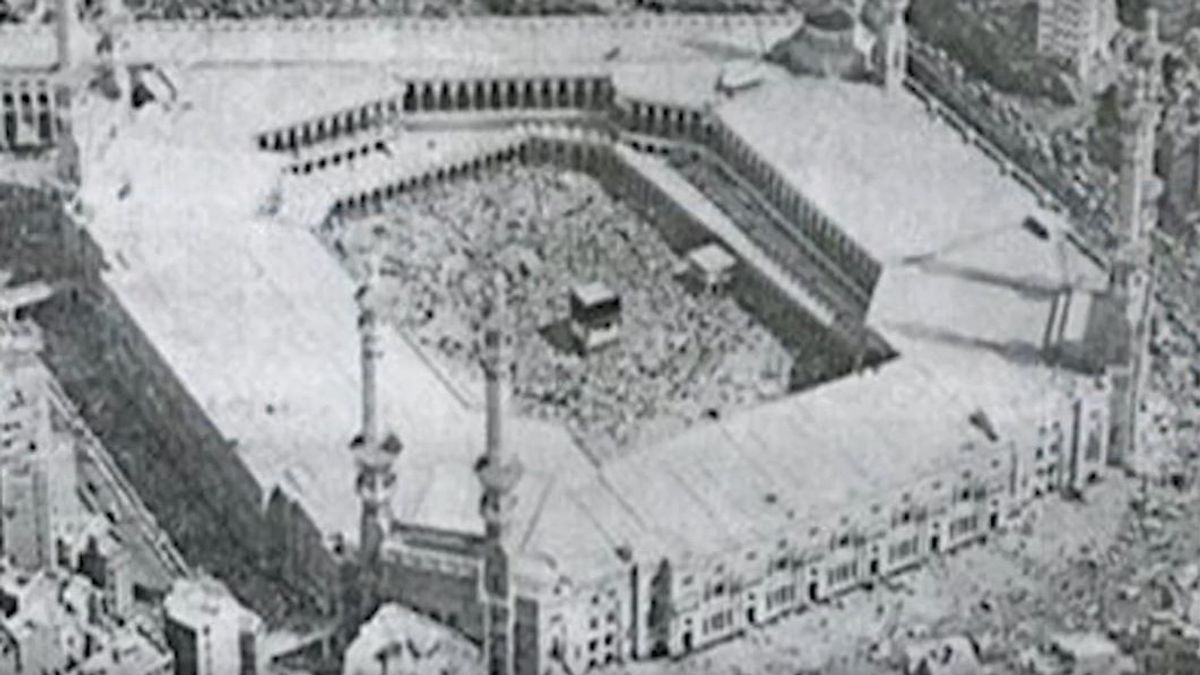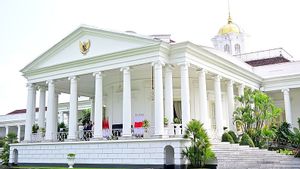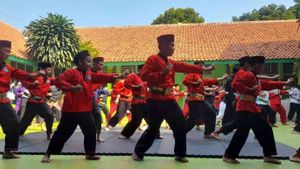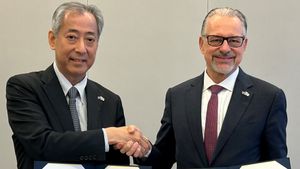JAKARTA - The end of 1979 is an important record in the history of the modern Islamic world. From November 20 to December 4, terror groups from within Islam and residents of Saudi Arabia made efforts to control the Kaaba and the Grand Mosque. This incident is actually very important to know in order to understand the Al Qaeda movement and other movements that have tarnished the face of modern Islam. Unfortunately, the details of this incident have tended to be covered up to this day.
In the morning, November 20, 40 years ago, hundreds of pilgrims who came from all over the world melted into a sea of people. Among them, hundreds of rebels, mostly Arabs of Bedouin descent, mingled. Social alienation and jealousy underlie their movement. Others are African-American. They changed religions because they were inspired by a new belief hardened by racial unrest in parts of the world. Some of the rebels were even inside the Grand Mosque. For days, they peeked at the curves of the connecting road between the buildings and the canals around.
At 5:18 a.m., after the Imam closed the Fajr prayer with a prayer, a series of sound of guns barked. Panic arose among the congregation when a young man carrying a gun was seen stepping towards the Ka'bah. The panic escalated when the other rebels took up arms. Police around the Grand Mosque, armed with sticks, tried to fight the rebels. As a result, two policemen were killed. The rest, prisoners. Amidst the chaos, Juhayman Al-Utaibi appeared. Together with three militants armed with rifles, pistols and daggers, he broke through the crowd and approached the Imam.
The chaos began to find its source. The priest identified Juhayman as the leader of the rebels. Imam also realized that the members of the rebels under him were people who had attended Juhayman's religious studies in Makkah. Then Juhayman, disrespectfully, pushed the Imam aside and grabbed the microphone. When the Imam tried to defend the microphone, one of Juhayman's men pulled out the dagger and shouted warning everyone that he was ready to stab and kill anyone in his way.
That scene made the panic worse. Thousands of people scrambled towards the wall of the fence to escape, leaving 51 trapped in the area of the Grand Mosque. The members of the armed group became increasingly violent. The muzzles were aimed at the crowd, blocking all exits. A number of congregations began to echo takbir. Unexpectedly, the armed group also shouted the same regalia. Amid the rumblings of takbir, Juhayman shouted a military call into the microphone.
Soon, his men installed machine guns on the top of the seven minarets of the Grand Mosque. The trapped congregation was forced to aid Juhayman's rebellion. Some were ordered to roll up thousands of rugs, others were forced at gunpoint to climb to the top of the tower, carrying water and crates of ammunition. Mastery of the seven towers provided space for snipers to keep tabs on the situation outside the Kaaba.
"If you see that the government soldiers are about to fight back, don't mind, shoot them, because they want to kill you! ... Don't hesitate!" exclaimed Juhayman to the snipers in his hoarse accent, quoted from Yaroslav Trofimov's The Siege of Mecca.
The atmosphere was gripping, full of crying women and children heard loudly, mixed with the coughing sounds of the elderly. The panic is perfectly preserved. The thousands of hostages, unable to speak Arabic, were confused. Juhayman seems to have prepared a way to solve the language problem. Immediately, he ordered to group the Pakistani and Indian congregations in one corner with the Pakistani-born rebels. His subordinates then translated the contents of the announcement into Urdu. Meanwhile, the African group was given a spokesperson in English.
"Sit down, sit down and listen!" exclaimed the armed group on cue while pointing the muzzles of their guns. "Mecca, Medina and Jeddah are now in our hands," the rebels declared their control through the public communication system around the Grand Mosque.
I was so loud, the cry was heard up to the middle of Makkah City. Juhayman then handed the microphone to a man named Sayid who mastered classical Arabic skills to explain the purpose of the crazy movement.
Explosive, Sayid explained the various crimes of the Saud Palace. Prince Fawaz, brother of the king and governor of Makkah, was mentioned. Fawaz's sex scandals and corruption and his habit of partying were considered shameful. In addition, the contamination of Western thoughts through television and various liberal policies such as allowing women to be active in public spaces is considered a danger. Moreover, the royal decree cooperated with the so-called infidels. For them, the Saudis' oath of allegiance to the kingdom was no longer valid because of the kingdom's deviation from Islamic law.
The appearance of Imam Mahdi
The confusion grew when Juhayman invited Muhammad Abdullah to the congregation. To the congregation, Juhayman introduced Muhammad Abdullah as Imam Mahdi. The prophecy has been fulfilled, he said. The calculation period has started, he said. The theory about the appearance of Imam Mahdi was also shared by Juhayman, including the red mole on Muhammad Abdullah's cheek. For a moment, Juhayman stopped his babbling to make an impact and to add dramatic effect to his narrative.
“That good man is now here with us, and he will bring justice to the world, after being filled with injustice. If you have any doubts, please come here and check. We are all your brothers! " exclaimed Juhayman.
Imam Mahdi, who was predicted by this armed group, approached the center of the Grand Mosque with a machine gun. He then stood in the shadow of the Ka'bah, between the tombs of Ishmael and Hajar and a large rock where the Prophet Abraham's footprints were found. The situation is structured according to the depiction of the Prophet Muhammad's hadith.
"In the name of Allah, the Most Gracious, the Most Merciful, this is the Imam Mahdi we have been waiting for," exclaimed Juhayman. "Swear to be loyal to brother Muhammad Abdullah Al-Quraish," he continued.
One by one the armed men of Juhayman bowed to kiss Muhammad Abdullah's hand and give allegiance with the words: We will obey you, in joy and in sorrow, in ease and in trouble, even in danger, except in what Allah does not approve of.
While shaking their hands, the hostages followed and made the same promise. While the chanting of the pledge was still going on, the Mahdi's brother Sayid said in an apologetic tone. "All of us who are here, without exception, must ask the public to return to the path of the Qur'an and Sunnah, even if this is contrary to what the government and the scholars have told you."
By taking baiat, it means formally transferring the support of the Saudi congregation from the royal family to the Imam Mahdi. After the Bai'at procession, Juhayman's group confiscated Saudi identity cards from the congregation. They tore up identities and beat worshipers. Juhayman's followers grew even more angry when they saw the beads used by many worshipers because they were considered heretics. A gunman approached the prayer beads and pushed them to the floor and opened fire.
Unable to remain silent watching the actions of Juhayman and his followers increasingly brutal, the Imam of the Grand Mosque, Sheikh Muhammad bin Subail, ran to a room to report this incident. He contacted Sheikh Nasir bin Rashid, reported the situation and asked for help. From that room, Imam Subail looked at the window and witnessed the shooting of the perpetrators of the rebellion towards the congregation.
He then tried to leave the Grand Mosque area through a police guard station. To an officer on duty, the Imam asked: Have you already contacted the leadership? However, the officer's answer surprised him. The officer who had been instigated by the story that Juhayman brought replied: We convey that the Imam Mahdi has come!
The story of Imam Mahdi in the style of Juhayman's group began to wake up since he and a number of his followers had the same dream about the arrival of Imam Hamdi. They believe in the figure of Muhammad Abdullah Al-Qahtani as Imam Mahdi. In the dream, they are said to have seen Muhammad Abdullah standing beside the Ka'bah and receiving allegiance as Imam Mahdi. The uniformity of this dream is considered miraculous because it is not only experienced by Juhayman's followers in Saudi Arabia, but also those in Lebanon, who have never even met Muhammad Abdullah.
At first, Muhammad Abdullah did not take the dream seriously, even though he also admitted to having had the same dream. Muhammad Abdullah, who was only 25 years old at that time, did not want to prolong the dream interpretation. However, Juhayman kept trying to convince Muhammad Abdullah that he was the chosen person who was destined to be the Imam Mahdi, the savior of the Islamic world. To expand support, Juhayman asked his teacher, Ibn Baz, to respond.
While in Riyadh, the cleric listened to theological arguments about the appearance of the Imam Mahdi who is believed to be Muhammad Abdullah. At that moment, Ibn Baz refused. Simple. Muhammad Abdullah did not meet the theological qualifications as Imam Mahdi. However, Juhayman was absurdly drowned in his conviction. He continued to whisper to Muhammad Abdullah that he was the Imam Mahdi. Gradually, Abdullah also sank into this belief.
Hatred of the kingdom
The establishment of the Kingdom of Saudi Arabia on 23 September 1932 by King Abdul Aziz bin Abdul Rahman Al Saud made the city of Makkah into the kingdom. Automatically, all of its management will become the will of the kingdom. During the leadership of King Abdul Aziz, Saudi Arabia, which was originally an area that was often underestimated because it had no natural resource potential, suddenly became a rich country. The 1938 discovery of petroleum in the region was the driving force. The potential is no joke. Saudi Arabia's oil is said to be able to supply a quarter of the world's oil needs.
With the help of the United States, the oil mining project in Saudi Arabia was officially run by Aramco (The Arabian American Oil Company). The Saudi Arabia-United States strategic alliance agreement that King Abdul Aziz and President Roosevelt agreed to at a dinner on the Quincy Ship marks the start of petroleum exploration in Saudi Arabia. The deal drew thousands of American construction engineers and experts to the Arab world. Modern roads, airfields, and office fortresses were built to launch exploration activities that recently hurt Saudi Arabia under the United States' monopoly over Aramco.
The clergy criticized the presence of these foreigners. One of them is Abdul Aziz Ibn Baz. In a speech in 1940, Ibn Baz expressed his refusal to come to Saudi Arabia by Westerners. Quoted from Gilles Kepel's article in The War for Muslim Minds, Ibn Baz said: The presence of infidels, male or female, is dangerous for Muslims. His beliefs, morality, and the education of his children. Offended by the speech, King Abdul Aziz imprisoned Ibn Baz.
The emergence of the commercial aircraft industry in the world has increased the number of pilgrims to Saudi Arabia every year. The Grand Mosque underwent a major expansion and renovation. The project is run by a loyal royal employee and a trusted advisor in development affairs, namely Muhammad Bin Laden, the father of Osama Bin Laden. He renovated the Grand Mosque, juggling it with great luxury. Muhammad Bin Laden was a trusted palace contractor who continued renovations until mid-1956-1970.
The modernization of Saudi Arabia was carried out on various fronts. The construction of malls and the entry of western films onto television enhanced the liberal attitude of the Saudi Arabian society that day. Not to mention the ideas that thousands of Saudi Arabian students and scholars brought home from the United States and Europe. Quoted from the writings of Holden and Johns in the book The House of Saud, liberalization is also seen from among the royal family, Crown Prince Fahd, whose reputation is known as a playboy and pro-America, is increasingly liberating Saudi Arabia. The emergence of casino localization and legalization as well as the entry of alcoholic beverage products triggered strong protests from the clerics, especially Ibn Baz, who at that time was already free from prison. The protests were even louder than in 1940.
Despite respecting him as a cleric, the royal party tended to ignore his protests. Ibn Baz tried to make changes from below. Taking advantage of his position as dean of the University of Medina, he developed a new da'wah movement opposite the kingdom. The movement is called Da'wah Salafiyah Al-Muhtasiba which means "an Islamic movement that follows the way of life of the Friends and which is carried out with noble ideals".
This da'wah network led by Ibn Baz soon expanded throughout the country. Criticism of the kingdom's policies, hatred of non-Muslims working at Aramco and all social change have been echoed in the study rooms of the Islamic University of Riyadh and Medina. Juhayman bin Saif Al-Utaibi became a member of this da'wah movement. Juhayman joined in 1973 after resigning the Saudi National Guard Army, the Saudi regime's special forces tasked with protecting the Al-Saud family from potential coups, both internal and external.
Quoted from the book The Siege of Mecca by Yaroslav Trofimov, it didn't take long for Juhayman to occupy an important position in the Da'wah organization of Al-Muhtasiba. In 1976, he became the movement coordinator for recruitment and overseeing the camps of Al-Muhtasiba leaders during the annual haj pilgrimage. In 1977, Juhayman's loyalty to Ibn Baz and the movement's senior clerics began to erode. According to him, movement for change cannot be carried out only by preaching to the community. He wanted a harder way. Of course his opinion was conflicted.
Influence the modern jihad movement
Juhayman then began writing to criticize. A book entitled Zilzal Juhayman Fi Makkah was published as a result of his thoughts. This thought will be followed by hundreds of followers who took part in the attack on the Grand Mosque. In fact, many parties believe that his thoughts have inspired the generation of jihadists in the later days. Juhayman's writings summarize the contradictions and actions of the Kingdom of Saudi Arabia that have damaged Islamic beliefs.
"Rial worship took place, films were imported, and books poisoned the minds of young people," he wrote in the book. . He also criticized the Commission for the Protection of Morals and the Prevention of Immorality, a state institution that maintains Islamic morality which is considered ineffective. "What does the commission mean if we still have cinemas, clubs and art shows?"
The article was published by Juhayman in early 1978. He sent it to the Kuwaiti Muslim Brotherhood activists. Juhayman was aware of the tight control of the Kingdom of Saudi Arabia at that time. In Kuwait, the publisher Dar Al-Talia is willing to print his writings into book form. Juhayman only had to pay for the printing fee because the publisher was affiliated with opponents of Saudi Arabia in Kuwait who were supported by the Baath Islamic Socialist Party of Iraq.
The book succeeded in influencing many of Juhayman's followers who took part in the attack on the Grand Mosque. Hajj season in 1979, the attack was carried out. The attack was well planned. Juhayman's group was even earlier trained to perfect their shooting skills. Training provided by veteran members of the Saudi National Guard. The movement began by taking advantage of the kingdom's attention, which at that time focused on the escalation of the conflict in the Persian Gulf, Iran after the attack on the US embassy in that country.
Juhayman's followers began to enter Makkah. They smuggle weapons and logistics through Fatah Gate in the northern part of Makkah which leads to a winding passage at the bottom of the Masjid al-Haram room, Qabu. Juhayman bribed the construction workers of the Bin Laden company who were still renovating the Grand Mosque as many as 40,000 rials, because only the workers of this company had access to the gates. Juhayman and his followers entered with three pickups of Toyota, Datsun and GMC which were parked on the ground floor of the Grand Mosque. The three cars were loaded with weapons, ammunition and food supplies.
Two weeks of fighting
Back to the attack on the Grand Mosque. At around 8:00 am, the Makkah police finally responded to this precarious situation. A police jeep was dispatched to monitor the chaos accumulating at the gate. The vehicle was under fire. Bullets fired by Juhayman's sniper from one of the towers shattered the windshield of the car, leaving the driver of the car injured and covered in blood.
After the first jeep failed, a large convoy of police moved slowly towards the other side of the shrine. Shortly thereafter, the rebels opened fire on the police troupe with raining bullets from the towers and upper windows. News of the Imam Mahdi's arrival soon spread, the people of Makkah were divided. Some began to believe the story that Juhayman had told him.
In Riyadh, King Khalid, who was ill at that time, heard the news from Sheikh Nasir bin Rashid, a senior cleric who served in the two holiest places of Mecca and Medina. King Khalid was confused as to how to react to this attack. He is confused because the royal family who has an important position is not in Saudi Arabia. The commander of the National Guard, Prince Abdullah, was in Morocco. Prince Faisal who is the head of the General Intelligence Directorate (GID) is also visiting Tunisia.
Information restrictions were put in place. Saudi Arabia is closed to foreign tourists and journalists. Local television and radio are also prohibited from broadcasting the news. King Khalid then summoned Ibn Baz and 29 other senior scholars to the Palace. He asked for suggestions to resolve this incident. However, the Grand Mosque is an area prohibited from all forms of warfare. Meanwhile, the Saudi National Guard continues to try to push to take over and restore the situation in Makkah.
The fighting between the Saudi Arabian army and Juhayman's group lasted two weeks. It started from 20 November to 4 December 1979. The rebellion of Juhayman and all his followers ended at 1:30 am. In the information he extracted, Juhayman called the rebellion he committed as God's will. During the press conference that day, Prince Nayef smiled broadly. How proud he was to see Saudi Arabian troops ending the attack with the consequence of what he described as an "extremely low number of casualties."
According to the information he conveyed, 60 people were declared dead. Another 200 were injured. "(Their death) It is better than all of us because they died as martyrs in the framework of serving God and defending His holy place," said Prince Nayef. From the rebel side, 75 were reportedly killed in the Grand Mosque. Another 170 were arrested, including 23 women and children who were Juhayman's wife and several sisters of Muhammad Abdullah who are said to have died in the second day of attack.
The most important figure among the prisoners appeared on the screen. Juhayman, the dark face drenched in water, sat on the hospital bed. Her hands were handcuffed behind her back. Juhayman was shown to the public accompanied by the angry voice of a Saudi TV news anchor. "Before you is Juhayman bin Saif al-Utaibi!"
According to Saudi government calculations, Juhayman and his rebels killed 12 Saudi officers and 115 worshipers. About 450 more soldiers were rushed to hospital because of the attacks by the rebels. The government's official statement that collected 270 people as victims of the Mecca rebellion was greeted with skepticism by western diplomats and independent observers. They believe that the Saudi government is covering up the true number of victims which is actually higher. According to their observations, at least more than a thousand people died in the bloody incident.
On the morning of January 9, 1980, 63 prisoners who had rebelled were sedated. With their bound condition, they were brought before the executioner's long steel sword. Beheading awaits. Following Saudi custom, the punishment was carried out in public, to ensure the government's message of assertiveness was heard far and wide. Juhayman's head was the first to roll into the sand in the Holy City of Mecca, where he had committed his crime.
The English, Chinese, Japanese, Arabic, and French versions are automatically generated by the AI. So there may still be inaccuracies in translating, please always see Indonesian as our main language. (system supported by DigitalSiber.id)










